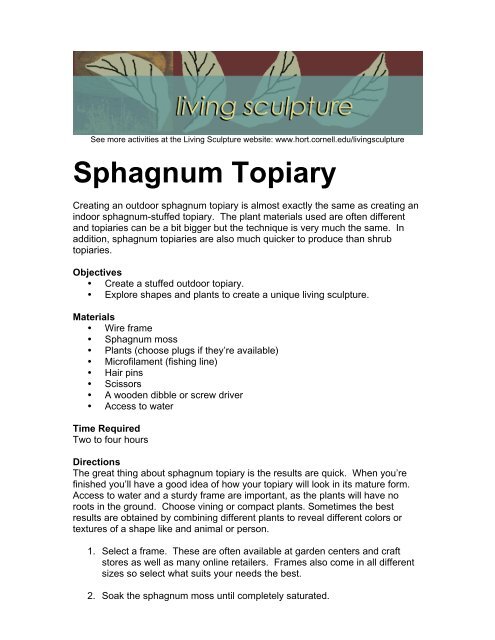Living Sculpture; Sphagnum Topiary
Living Sculpture; Sphagnum Topiary
Living Sculpture; Sphagnum Topiary
Create successful ePaper yourself
Turn your PDF publications into a flip-book with our unique Google optimized e-Paper software.
See more activities at the <strong>Living</strong> <strong>Sculpture</strong> website: www.hort.cornell.edu/livingsculpture<br />
<strong>Sphagnum</strong> <strong>Topiary</strong><br />
Creating an outdoor sphagnum topiary is almost exactly the same as creating an<br />
indoor sphagnum-stuffed topiary. The plant materials used are often different<br />
and topiaries can be a bit bigger but the technique is very much the same. In<br />
addition, sphagnum topiaries are also much quicker to produce than shrub<br />
topiaries.<br />
Objectives<br />
• Create a stuffed outdoor topiary.<br />
• Explore shapes and plants to create a unique living sculpture.<br />
Materials<br />
• Wire frame<br />
• <strong>Sphagnum</strong> moss<br />
• Plants (choose plugs if they’re available)<br />
• Microfilament (fishing line)<br />
• Hair pins<br />
• Scissors<br />
• A wooden dibble or screw driver<br />
• Access to water<br />
Time Required<br />
Two to four hours<br />
Directions<br />
The great thing about sphagnum topiary is the results are quick. When you’re<br />
finished you’ll have a good idea of how your topiary will look in its mature form.<br />
Access to water and a sturdy frame are important, as the plants will have no<br />
roots in the ground. Choose vining or compact plants. Sometimes the best<br />
results are obtained by combining different plants to reveal different colors or<br />
textures of a shape like and animal or person.<br />
1. Select a frame. These are often available at garden centers and craft<br />
stores as well as many online retailers. Frames also come in all different<br />
sizes so select what suits your needs the best.<br />
2. Soak the sphagnum moss until completely saturated.
3. Stuff the frame by packing the wet sphagnum very tightly. When you think<br />
the frame is full, add more. If your frame has extremities like legs or a tail,<br />
start with them first and then move into the bigger areas of the frame. You<br />
want your frame very full, to the point where you can’t quite see the frame<br />
anymore but can feel it under a layer of the sphagnum.<br />
4. Use the microfilament the tightly wrap sections of the frame. Start by tying<br />
one end to the frame, wrapping tightly and evenly (you don’t want to be<br />
able to see the microfilament so space it accordingly) then tying the other<br />
end off to the frame as well.<br />
5. Take a step back and see how things are looking. You can use scissors to<br />
trim any sphagnum that seems to be sticking way out of place.<br />
6. Have all your plants ready to go and well watered before you start<br />
planting. You may want to strategize and mark with a toothpick where you<br />
anticipate planting.<br />
7. Using a wooden dribble or screwdriver, make a one planting hole. You’ll<br />
have to push hard. Be ready to plant, as the moss will fill back in quickly.<br />
8. Place the plant plugs into the planting holes securely. Cover the exposed<br />
soil with the moss.<br />
9. If using vining plants, extend the runners along the surface of the moss<br />
and use hair pins to secure. If kept moist, these stems will root into the<br />
moss.<br />
10. Be sure to place the topiary where it will get adequate sunlight. Check<br />
everyday for water. You can spray gently with a hose of spray bottle or if<br />
small enough, submerge in a pail of water. Never let your topiary dry out.<br />
11. Because the sphagnum moss doesn’t provide the plants with any<br />
nutrients, you’ll need to fertilize every other week during the growing<br />
season and about once a month in the winter. Use a diluted liquid<br />
fertilizer after watering.<br />
12. Continue to prune and pin trailing vines as needed to maintain shape and<br />
encourage the topiary to fill in.<br />
Cornell Garden-Based Learning Program website: www.hort.cornell.edu/gbl

















